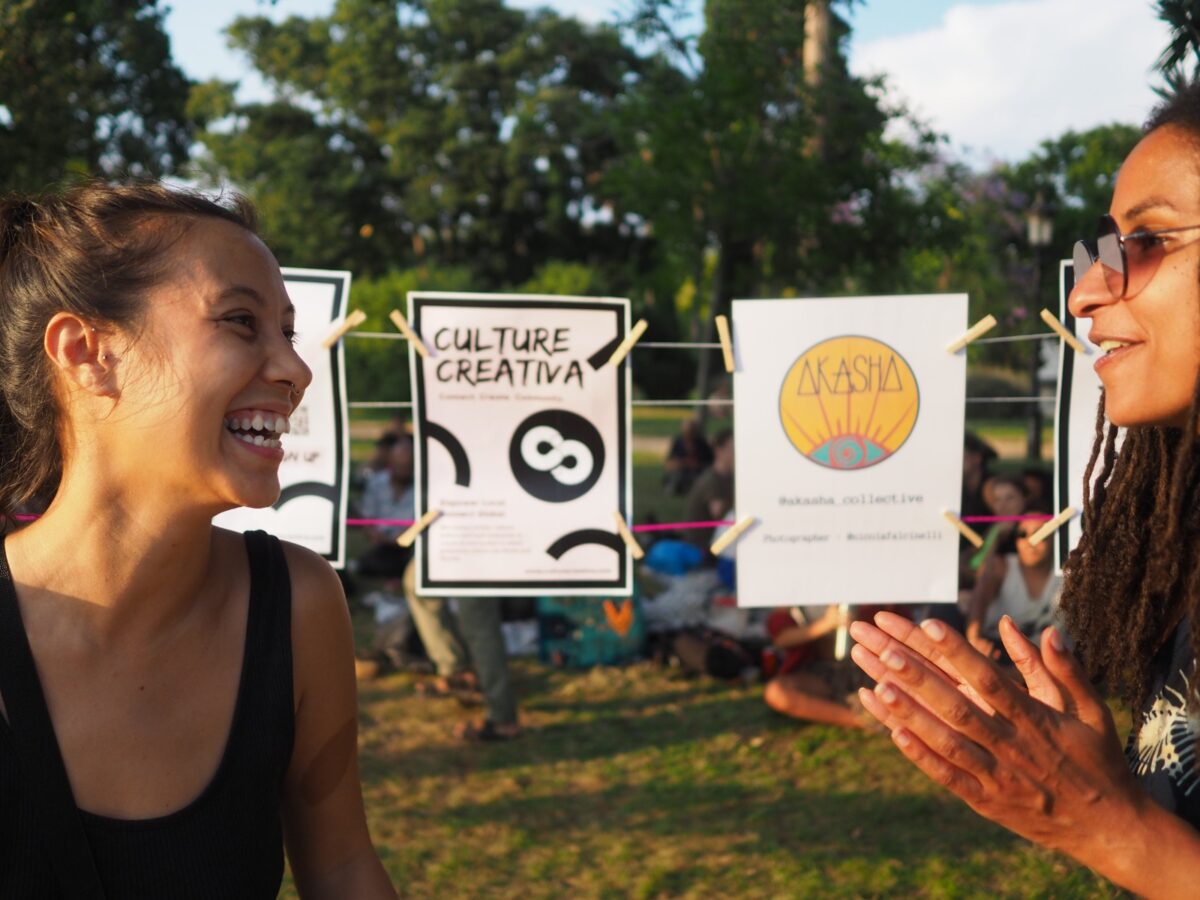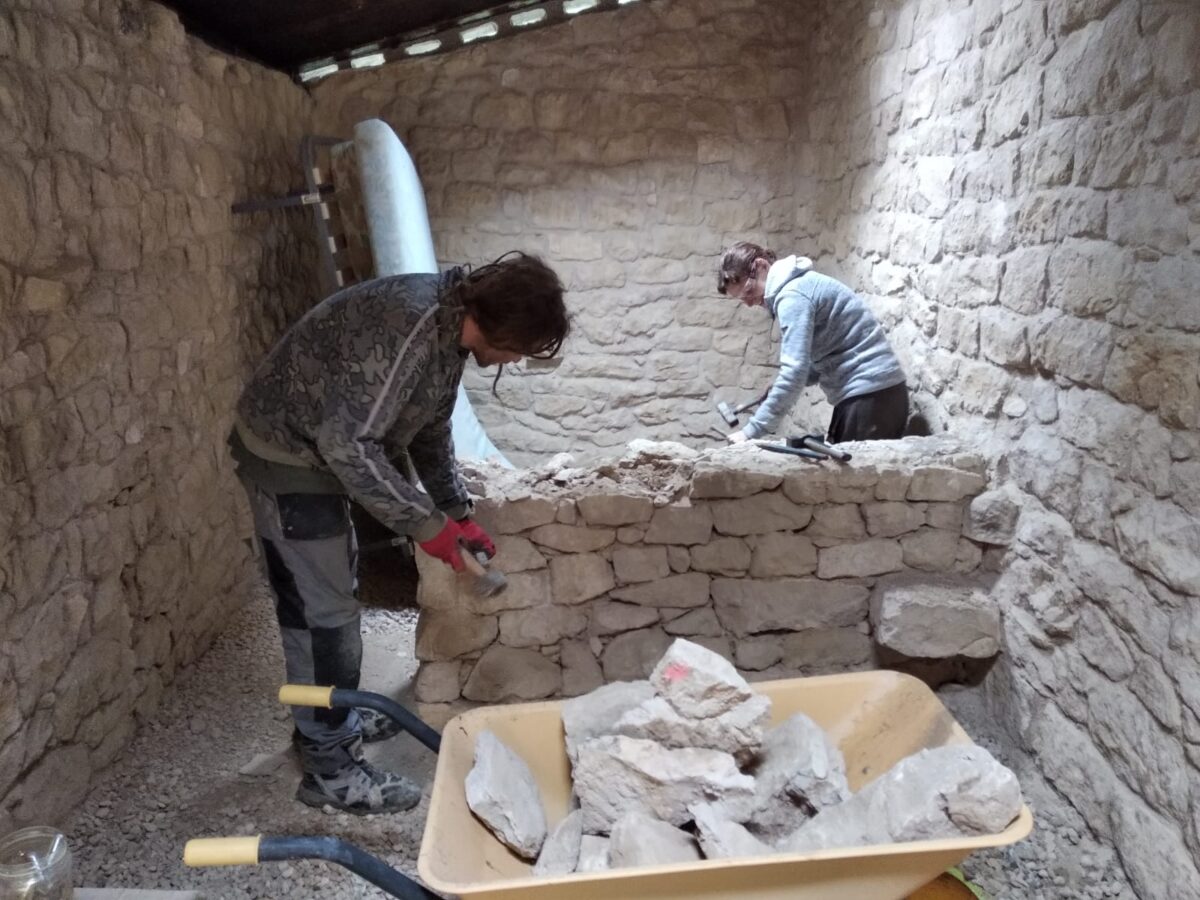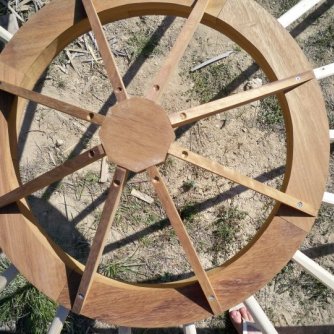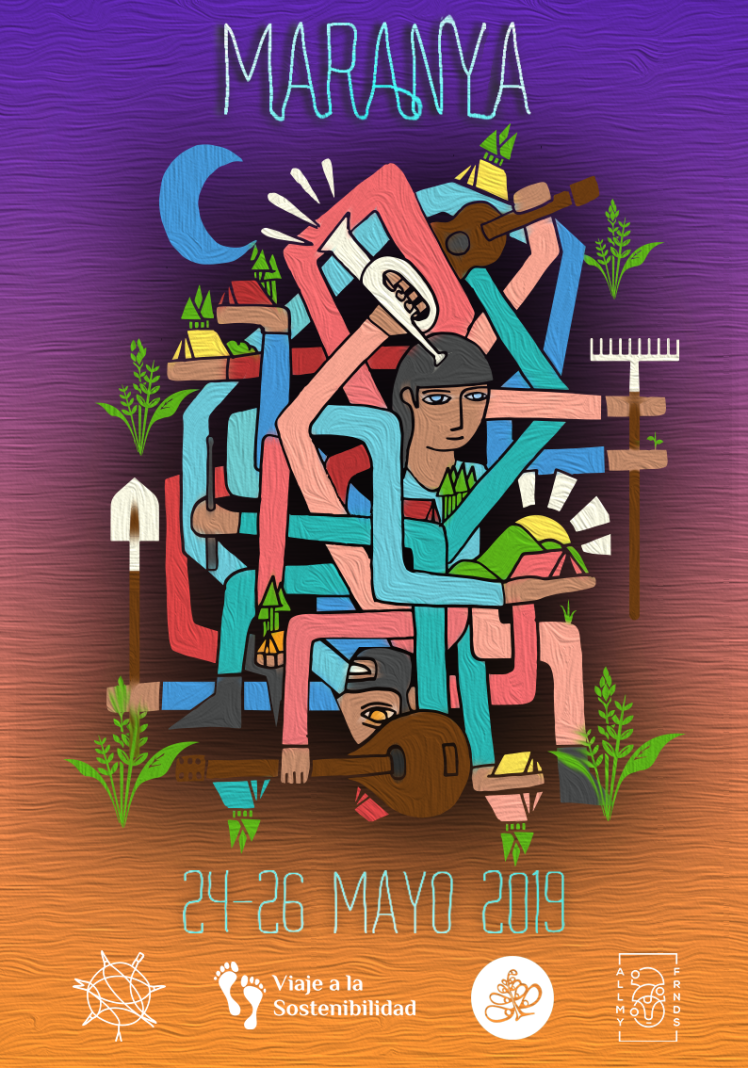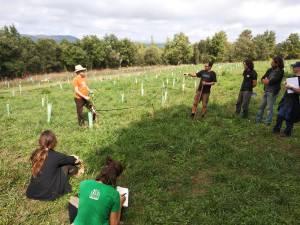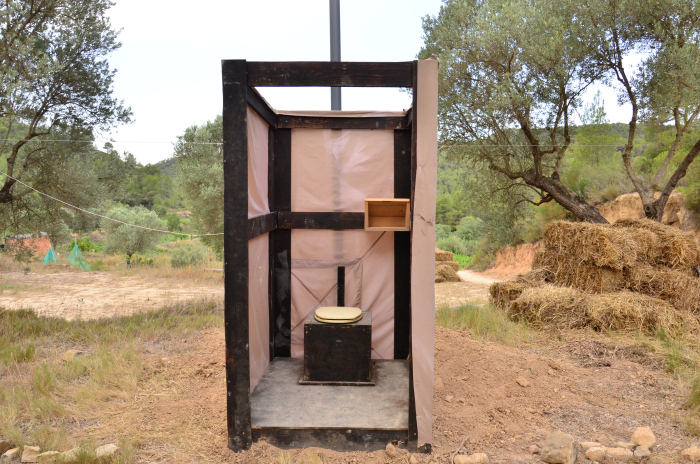10th April 2010
Saturday, our first day building the yurt with the team.
sharpening the chisel – 3 hours
marking out the circle – 3 minutes
at the stinking rubbish dump sawing bits of wood to make floor bearers – 2 hours. key team members: arnau, gary, gary’s right testicle, pau, anna (officially NOT a fascist leader) and a dead cat.
making roof poles round at the end with a fantastically sharp chisel – 1 hour. rob d
drilling holes in the wall posts – 1 hour. phil
trench digging where the bearers will lie on the ground – 1 hour. team members chuk, maskell and smallchuk
lunch. yoopeee. perfect. coffee
levelling bearers and laying and nailing down floorboards on them- hours
tying the wall posts together with the most crucial building material… string – painfully slow and too many blisters
discussing whether to bury the door frame instead of sawing it – yes
discussing whether anna is, in fact, a fascist
wondering whether arnau will get out of the hammock, and whether it was just the morning beer that caused him to drive my van into a wall,
by sundown: floorboards looking flat, wall looking stringy, imminent football match being discussed, arnau’s car battery run down, some not that warm solar showers taken and beer drunk
by 3am .. most people full of wine and on their way to bed
11th April 2010
Sunday. nutella. coffee and tea at the same time. relatively low level of functioning all round.
more floorboards and wedging extra bits of wood under the bendy places,
more and more and more tying wall poles together – second half of wall started
heat. hunger. lunch. river trip option turned down because people are keen to crack on (and they were sitting in the shade at the time)
trying to make the lattice walls have a straight end, running out of string
hole digging so we can bury the doorframe and make a hobbit door.
starting to realise that we are not actually going to get this bastard put together by sundown… but we all had plenty of time to eat pancakes and hot potatoes.
most importantly there are volunteers to come back in a fortnight (24th April) and carry on
BIG UP THE TEAM !!!
24th and 25th April 2010
the very first thing i did this weekend was cut a piece of string and then into my finger with a stanley knife.
classy. i think the workers were impressed
me and phil did get some stuff done though.. we finished tying the second part of the wall, layed a few more bits of flooring (when i say layed, i mean put on the ground) and cut the edge of one of the foorboards as neatly as we could with a pruning saw. a jig saw is, i believe, the name of the tool that would have been suitable for that job.
by sun down we were appreciating beer, practicing going in and out of the hobbit doorway, and realising that hammering down the new flooring may be a rash move. new tasks should aways be thought through twice, preferably discussed with a team who’ve not had three estrellas, and in this case the chance of completely f***ing everything up was high enough to stop us. (that’s something i really need to watch out for when i’m building the real house.)
phil discovered the full horror of packing up in the heat on sunday morning but by the time we got up into the mountains and were actually touching the “three heads” (officially Rocas de Benet) we forgot about that,
“there’s so much rock it kind of blows your mind. there’s so much fucking rock” – Phil. 25/04/10
we walked through pine trees, under eagles, next to cliffs, across a trickling muddy attempt at a stream, up spiky rocks and discovered awesomeness in the true sense of the word when we sent echoes reverberating through valleys away to the edge of the park.
6th June 2010
guapos… i have a door!!!!
ok so it’s not a hanging door, but i think the door hinging task is made way easier by working with bare earth, if its too big i just dig
for those of you who think “well that looks like shit” can i remind you that i/we built it ourselves with the combined level of skill of maskell’s gcse technology class plus a bit of life experience, there was nothing there before and now there’s a yurt and its beautiful
i will sleep in it soon but my bed in the house is just so cosy and the night still has a bit of a chill, not to mention howling jabalíes
13th June 2010
My first sleep in the yurt!
And it wasn’t too freezing and I had beautiful dreams
i finished the yurt door – its on hinges these days and the walls are properly attached. it turns out that digging down to make space for the door to open is not a very good idea at all, know why?
You get a puddle, right in the doorway when it rains!
18th August 2010
The floor is finished!
floor recipe : old beams from the tip, bits of ceiling board, old wardrobe and luxury pallets nailed on. and a few carefully chosen rocks wedged under the dodgy bits. 1000 nails = $4.85 euros 25 nails = 1.25 euros and then i used a shitload more than i thought i would. i’m starting to think that i can do things pretty well myself, it just takes about 5-10 times as long as a pro – but i’m getting pretty nifty with a chisel.
13th September 2010
Fitting a sink, (no thanks to Phil)
something tells me that a piece of chipboard from an old cupboard is not strong enough to support a sink, but when has that ever stopped me before? Marcos told me again that he thinks the whole ger will come down at the first snowfall
so i bought those cheap a-frame things and fixed some extra supporting metal bits, laid the chipboard on top and spent ages making it fit neatly over the screws, then spent a proper ages trying to draw a smaller circle exactly 2.6 cm inside the outline of the sink
finally got round to the fun bit – sawing the hole out – and was rudely brought to a halt by phil breaking saw blade approximately 3 seconds after he started “helping”
so as usual, next weeks job is just a continuation of last weeks. one day i will learn that things take a really long time. (and never think about how fast it could be done if you took it to the wood shop)
good news : la pesquera near beceite is properly lush and swimming under the waterfalls for ten minutes made up for all the DIY sweating,
bad news : erm, ahem, bed bugs – there’s still a few hanging out in the guest suite. damn and DAMN, saw gary naked – to go with the testicle leakage mentioned in a previous post, (maybe that should be good news, sorry gary)
winner of the shooting star contest : phil with 225 points
2nd November 2010
Insulated but creaking
to those of you who don’t believe in the strength of the yurt have to admit that the roof blew off on monday. but only partly and only until me and bernat wrestled with it and forced it back down again with more tent pegs. it creaks quite a lot now
but on the bright side there’s a proper double bed in it now – ha ha! it fitted through the tiny hobbit door!!
the sides have been pegged down and covered with gravel for the winter and we hung up (fireproofed) curtains/blankets/towels all over the inside for insulation.
the porch wall continues to be an interesting experiment in building with fecal matter. the second section perches relatively precariously on top of the first – this wall will not be very straight – and i’ll be very impressed if our carefully m¡xed render is actually weatherproof; horseshit, flour and water goo, powdered milk, straw, sand, and olive oil.
15th November 2010
diy chimney instalation follwed by fire emergency
Friday : mission – buy a stove and a sheet of aluminium 40cm x 40cm with a chimney sized hole in the middle.
12:00 Encants market – stove €89, hot water bottle €6.95 (how did i ever live without one..)
12:30 asked around – hardware store, then industrial machine type shop and am now waiting outside a tiny backstreet door labeled “metallisteria”. a woman in a tabard moping the pavement assured me he would be back soon.
12:47 have decided to stick the chimney fitting together with velcro and just bought some
13:07 give up waiting, but then bump into metal man on the street who grumpily talks in terms of “days” to cut the aluminium and he wants exact measurements. apart from anything else this sounds pricey. (i am on a budget of zero- or verrry fecking close to)
13:28 at the organic veg. patch in horta to buy little baby cabbage, cauliflower, chard and leeks from a man in a wheelchair whose daughter speaks english and mandarin.
15:45 at Leroy Merlin (ie B&Q) where they have some aluminium but cut nothing to size
16:00 followed a sign saying aluminium at the industrial estate, they gave me directions to a place that actually sells aluminium who are now giving me extremely convoluted directions to the other industrial estate where i may be able to get what i need.
16:25 chuffed about successfully following directions but can’t remember shop name, randomly pull in here to ask directions. my, is that a pile of metal offcuts next to a huge machine that slices metal? i think it is
the stubbly man in a boiler suit was smoking while he found a sheet roughly the right size and got to work. the heavy machine pins down the metal then “bummff” slices it. he played around with tubes connected to compressed air and then used a solder to cut the circle.
between him and the other guy who had his ipod on while trying to resurrect a rusty car chassis i was expecting a horrific accident at any moment. my joy at finding this cheap and cheerful workshop was slightly dampened when it turned out not to be cheap – €10 was double what i expected, but i got it. yoop.
15:48 the windfarm near Caseres looks kind of impressive when there’s an orange sunset.
19:18 building supplies shop Calaceite : after discussing the best positioning for the chimney jigsaw and which types of tape i need for fudging together things that get hot, i was gossiping with the owners of the shop about the english caravan invasion and how the council is trying to ban them. i can understand why when the only light apart from the stars on the Arens road is from a tv inside a luxury motorhome parked permanently in a deserted valley.
21:35 soup and trying to decide if karl pilkington could ever be funny
22:10 hot water bottle, wooly hat, fluffy socks and two duvets
Saturday : mission – put the stove in and go to an “eco-fair” in a nearby town
10:07 building a wall out of a mixture of horseshit and powdered milk which has now gone sour and absolutely stinks
11:00 deciding where to put the stove
11:12 clearing out the insects i found living in the folds of the insulation. this could be a fun weekly task 🙁
11:32 still deciding where to put the stove so there’s maximum gap between the chimney and the wall
15:32 done but not tested and on the way to Ráfales
17:35 beautiful town, shit fair.
i don’t think a stand with imported plastic toys should be allowed to feature in anything eco. there were a couple of people promoting biomass and a talk on farm subsidies by a dull government bod. i was happy to stick it out until he finally reached his point, but Marcos was less patient.
18:35 after dark waterfall exploration – El Salt – AWESOME!!
19:05 stopped for a beer in Valderobres
02:35 after two hours in an almost empty bar playing eurocheese techno Marcos is still insiting this is the last drink befroe he takes me home. why didn’t i drive?????
the streets are rammed with gangs of teenagers in tiny skirts and thigh high boots. this is their night of the year or something, hundreds of them totttering and shouting.
“no Marcos i don’t want to go to the disco with them….”
04:52 home at last and its cold enough to warrant stove testing
04:58 yurt filled with chemical smelling smoke, water thrown on fire and evacuation to sleep in the house. more experimentation required during daylight hours with company. there was a definite panic right there, is this because i bought the cheap stove? eeeek
Sunday : mission – plant veg, tidy up and go home
20:17 success
29th November 2010
outside it was cold enough to freeze the water in the kitchen sink solid
inside the yurt : 22º
hell yeah
the chemical smoke mostly burnt away by late friday night and my chorizo chick pea soup was cooking on the stove. i would never have eaten that 4 years ago. i’m turning catalan
Winter vs the Yurt – Round 4
Apr 20, 2015
Boodaville is looking great! We made our first visit of the year this weekend with family and friends and the high rainfall has definitely not done any (permanent) harm to the site.
The yurt and the old house suffered the same fate as last winter with bits of the roof being ripped off, but at least this year we weren’t robbed.
10th April 2016
The yurt has been taken down, to make space for the geodesic dome!




